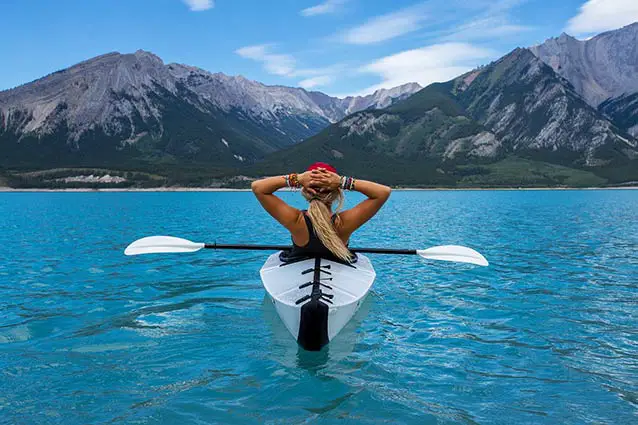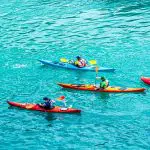It’s a question that’s plagued mankind since we first started building boats and setting sail on the open ocean: can you cook in a kayak?
Okay, so maybe “plagued” isn’t the right word, but there are at least a few people out there who would really like to know if it’s possible to cook a meal in a sit-inside (or sit-on-top) kayak. Furthermore, if it is possible, how do you do it, and what are some of the best meals you can cook in a kayak?
Contents
Should You Cook In a Kayak?
Okay, let’s get this question out of the way right at the top. Should you cook in a kayak?
Not unless you are an experienced kayaker and a skilled and careful cook using proper equipment. Cooking in a kayak, particularly one that’s actively floating in a body of water, is dangerous.
Whether it’s made of wood or plastic, a kayak stands a good chance of catching fire or melting when exposed to high heat, such as will be produced by a camp stove. Couple that with the unstable nature of, you know, water, and you have a sure-fire recipe for disaster or at least severe burns.
Finally, keep in mind that cooking requires equipment beyond just a stove. You will also need to bring fuel, at least one pot or pan, and utensils to cook with. Space in a kayak is limited, so think hard about whether you really need all that cooking equipment, or whether you might be better off sticking with cold food and saving your precious space for freshwater.
Related: Stove on boats: Electric vs Propane
What if You’re Experienced?
I can see you’re not going to let this go…
If you are an experienced (and I mean really experienced) kayaker, with access to good, professional equipment, then cooking in a kayak could be attempted with the proper gear. Please note that under no circumstance do I recommend cooking while underway in a kayak – it should be done only while anchored near shore in calm conditions.
A small gimbaled stove like a Forespar Mini Galley is your best option for cooking in a kayak, as the gimble will keep your pot from spilling or falling over if the kayak rocks or tilts. The next-best option is small backpacking or MSR canister stove, like a JetBoil MicroMo or MSR Pocket Rocket 2. The canister loses heat while cooking, meaning that the chances of it melting through the bottom of your kayak are slim to none.
The addition of a heat-resistant mat or tray underneath the stove will help. Extreme care should be taken while the stove is lit, as it will become very hot and the risk of burning your leg is high. It’s a good idea to create a windshield around the stove, which can double as leg protection. Some stoves come with built-in windshields.
Recommended reading: Oru and Trak – World’s Most Portable Kayak
What Meals Can I Make in a Kayak?
Let’s assume that you want to take your kayaking culinary experience beyond rehydrated packets of freeze-dried meals, and dive into some delicious and easy-to-make recipes (both hot and cold) that can be prepared without leaving your boat.
Pan-Fried Fish
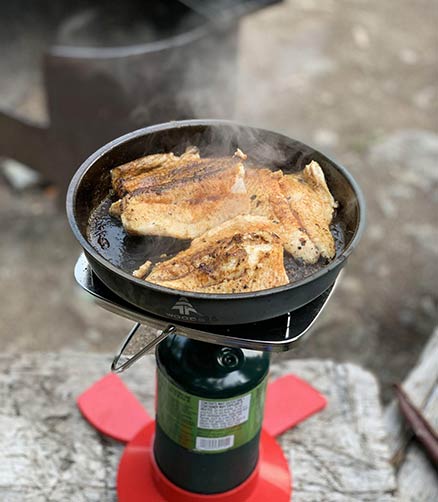
If you’re dead-set on cooking in your kayak, then without a doubt the best thing you can cook is a simple pan-fried fish that you caught yourself. The cooking equipment required is minimal – just your stove and a pan – and there’s no chance that you’ll spill boiling water all over yourself.
The caveat to this meal is that you need to know a) how to fish, b) which fish you are allowed to catch and which fish you can safely eat, c) how to keep a fish fresh, and d) how to clean and prepare a fish you have caught. You’ll also need to pack fishing equipment, a filet knife, and a surface upon which to prepare the fish.
Given that you have mastered all of the above skills, pan-fried fish is a simple, delicious, and healthy meal. Bring some squash or zucchini with you to eat as an aside. These can be cooked in the same pan after the fish is finished, using the oil that came out of the fish.
Pan-Fried Tofu
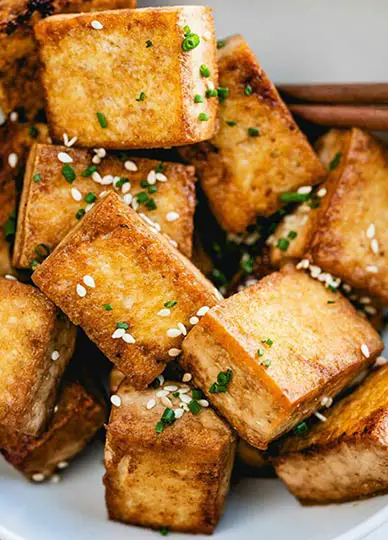
If you’re not a fisherman-or-woman, and you need to get your nightly fix of hot protein, then pan-fried tofu is the next best thing to pan-fried fish. Many brands of tofu are shelf-stable, meaning they don’t need to be refrigerated like chicken or beef does, and the cooking process is the same as pan-frying a fish. Paired with a simple vegetable, this makes a filling and healthy hot meal.
Again, at the very least you will need a knife to chop the tofu into manageable pieces, and a surface upon which to do it.
Turkey (or Ham, or Chicken, or…) Wraps
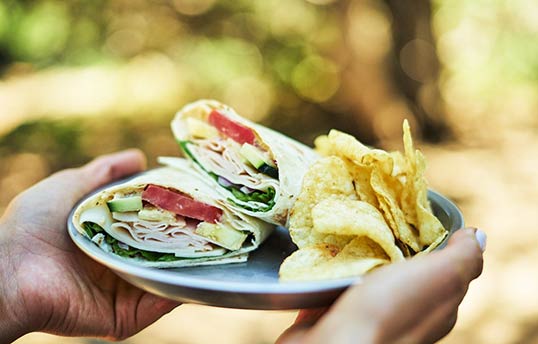
Wraps are great hot or cold, and preferable to sandwiches when you have limited storage space because tortillas take up much less space than sliced bread. They can be made with any kind of deli meat, or any kind of ready-to-eat protein, including pre-cooked chicken, sausage, ground beef, or tofu.
Freeze pre-cooked foods or sliced deli meats in zip-locks and keep them inside an insulated soft cooler at the very bottom of the boat until you’re ready to use them.
Wraps can be easily assembled as long as you have a surface to assemble them on and can be filled with pretty much anything. Heating a wrap is as easy as cooking pan-fried fish or tofu – simply place the wrap in your pan over heat for 5-10 minutes.
Shredded cabbage is a nice option if you want to include greens because cabbage is tougher than lettuce and won’t wilt as easily while stored without refrigeration.
Restaurant packets of mustard, mayonnaise, and hot sauce are great space-saving flavor enhancers.
Tuna or Chicken Salad, Crackers, and Cut Vegetables with Dip
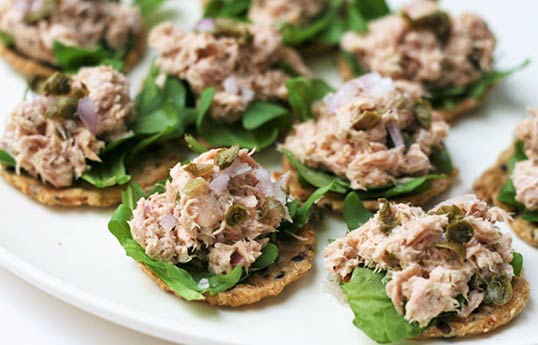
Canned tuna and chicken are excellent options for kayaking lunches. You can easily prepare the salad inside the can by draining off the water or oil that the meat is packed in, adding mayonnaise and powdered spices, and mixing with a fork. Spread the salad on crackers and pair that with some cut vegetables and a hearty, satisfying dip like hummus.
Salt, pepper, onion powder, and garlic powder are stapled seasonings that every kayaker should carry with them. Powdered spices take up very little room, weigh next to nothing, and turn a boring meal into a delicious one.
Snacks
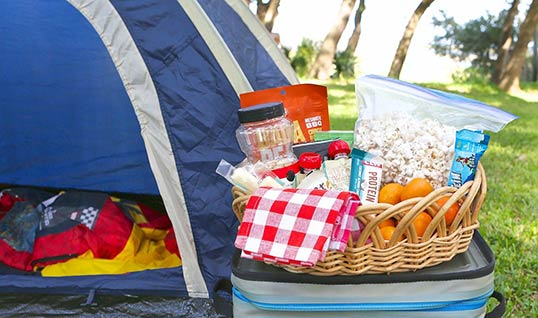
On a multi-day kayaking trip, you’ll often be paddling for many hours at a time, which means you’ll be burning a lot of calories. More energy expended means that you’ll need to up your calorie intake to keep up, so snacks become majorly important. You should plan to eat a snack between each meal, and don’t be afraid to treat yourself to dessert at the end of the day.
Carbohydrates will keep you fueled, so be sure to pack plenty of granola bars, fruit, crackers, chips, and even candy. Protein will rebuild your muscles after a hard day’s work, so string cheese, protein bars, and peanut butter are also good choices.
Last Tips
Whether you will be cooking in your kayak, camp cooking, or relying on cold or pre-packaged food, always make sure to schedule your full meal plan ahead of time, including the number of portions and utensils you’ll need to prepare each meal. Include a margin of an additional 25% to account for larger-than-expected appetites and potential food loss.
Use your meal plan to grocery shop and pack for the trip, then enjoy the fruits of your labor while you’re out on the water!
